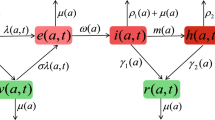Abstract
We consider a two-group epidemic model with treatment and establish a final size relation that gives the extent of the epidemic. This relation can be established with arbitrary mixing between the groups even though it may not be feasible to determine the reproduction number for the model. If the mixing of the two groups is proportionate, there is an explicit expression for the reproductive number and the final size relation is expressible in terms of the components of the reproduction number. We also extend the results to a two-group influenza model with proportionate mixing. Some numerical simulations suggest that (i) the assumption of no disease deaths is a good approximation if the disease death rate is small and (ii) a one-group model is a close approximation to a two-group model but a two-group model is necessary for comparing targeted treatment strategies.
Similar content being viewed by others
References
Arino, J., Brauer, F., van den Driessche, P., Watmough, J., Wu, J., 2006. Simple models for containment of a pandemic. J. R. Soc. Interface 3, 453–57.
Arino, J., Brauer, F., van den Driessche, P., Watmough, J., Wu, J., 2007. A final size relation for epidemic models. Math. Biosci. Eng. 4, 159–76.
Arino, J., Brauer, F., van den Driessche, P., Watmough, J., Wu, J., 2008. A model for influenza with vaccination and antiviral treatment. Math. Biosci. Eng. 5, 118–30.
Bansal, S., Pourbohloul, B., Meyers, L.A., 2006. A comparative analysis of influenza vaccination programs. PLoS Med. 3, 1816–825.
Brauer, F., 2005. The Kermack-McKendrick epidemic model revisited. Math. Biosci. 198, 119–31.
Diekmann, O., Heesterbeek, J.A.P., 2000. Mathematical Epidemiology of Infectious Diseases. Wiley, Chichester.
Duerr, H.P., Brockmann, S.O., Piechotowski, I., Schwenn, M., Eichner, M., 2007. Influenza pandemic intervention planning using InfluSim: pharmaceutical and non-pharmaceutical interventions. BMC Infect. Dis. 7, 76–0.
Dushoff, J., Plotkin, J.B., Viboud, C., Simonsen, L., Miller, M., Loeb, M., Earn, D.J.D., 2007. Vaccinating to protect a vulnerable subpopulation. PLoS Med. 4, 921–27.
Ferguson, N.M., Cummings, D.A.T., Cauchemez, S., Fraser, C., Riley, S., Meeyai, A., Iamsirithaworn, S., Burke, D.S., 2005. Strategies for containing an emerging influenza pandemic in Southeast Asia. Nature 437, 209–14.
Gani, R., Hughes, H., Griffin, T., Medlock, J., Leach, S., 2005. Potential impact of antiviral use on hospitalizations during influenza pandemic. Emerg. Infect. Dis. 11, 1355–362.
Longini, I.M., Halloran, M.E., 2005. Strategy for distribution of influenza vaccine to high-risk groups and children. Am. J. Epidem. 161, 303–06.
Longini, I.M., Halloran, M.E., Nizam, A., Yang, Y., 2004. Containing pandemic influenza with antiviral agents. Am. J. Epidem. 159, 623–33.
Longini, I.M., Nizam, A., Xu, S., Ungchusak, K., Hanshaoworakul, W., Cummings, D.A.T., Halloran, M.E., 2005. Containing pandemic influenza at the source. Science 309, 1083–087.
Ma, J., Earn, D.J.D., 2006. Generality of the final size formula for an epidemic of a newly invading infectious disease. Bull. Math. Biol. 68, 679–02.
Meyers, L.A., 2007. Contact network epidemiology: Bond percolation applied to infectious disease prediction and control. Bull. Am. Math. Soc. 44, 63–6.
Nold, A., 1980. Heterogeneity in disease transmission modeling. Math. Biosci. 52, 227–40.
Nuño, M., Chowell, G., Gumel, A.B., 2007. Assessing the role of basic control measures, antivirals and vaccine in curtailing pandemic influenza: scenarios for the US, UK and the Netherlands. J. R. Soc. Interface 4, 505–21.
van den Driessche, P., Watmough, J., 2002. Reproduction numbers and subthreshold endemic equilibria for compartmental models of disease transmission. Math. Biosci. 180, 29–8.
Welliver, R., Monto, A.S., Carewicz, O., Schatteman, E., Hassman M, M., Hedrick, J., Jackson, H.C., Huson, L., Ward, P., Oxford, J.S., 2001. Effectiveness of oseltamivir in preventing influenza in household contacts: a randomized controlled trial. JAMA 285, 748–54.
Author information
Authors and Affiliations
Corresponding author
Additional information
This research was supported by MITACS and an NSERC Research Grant.
Rights and permissions
About this article
Cite this article
Brauer, F. Epidemic Models with Heterogeneous Mixing and Treatment. Bull. Math. Biol. 70, 1869–1885 (2008). https://doi.org/10.1007/s11538-008-9326-1
Received:
Accepted:
Published:
Issue Date:
DOI: https://doi.org/10.1007/s11538-008-9326-1




